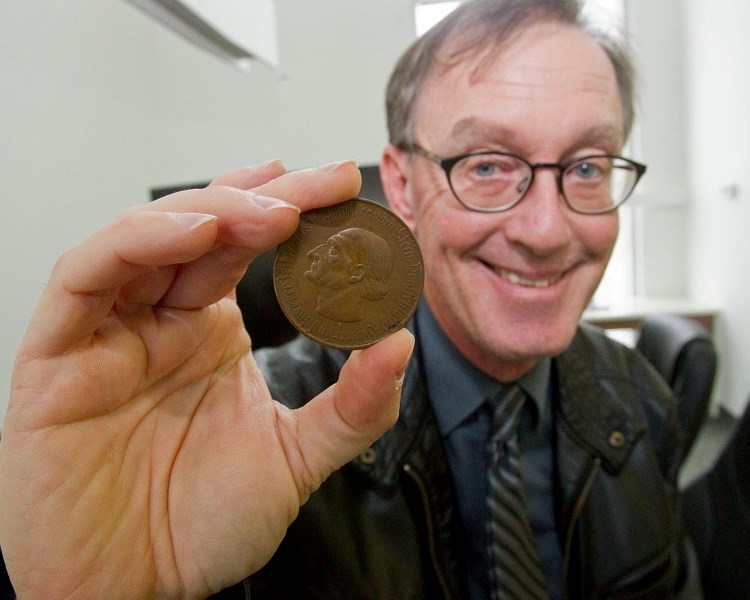Ten thousand of anything is a lot.
Yet, Ron Darbyshire can hold 10,000 German marks in one hand.
Germany had hyperinflation during and after the First World War, notes the Edmonton coin collector (or numismatist), which led to some absurd denominations such as this 10,000-mark coin. It's the size of an Oreo, the weight of several toonies, and wouldn't even get you a cup of coffee back when it was minted.
"It's just mind-boggling."
Darbyshire is giving a free talk on the coins of the First World War next Thursday at the St. Albert Public Library.
It's part of a series of events the library has organized to commemorate Remembrance Day and the 100th anniversary of the start of that war, says librarian Michelle Papineau-Couture.
"He's so enthusiastic," she says of Darbyshire, and will have many period coins on hand for guests to see and touch.
The First World War was a pivotal moment in Canada's history and its maturation, Papineau-Couture notes.
"It's important to remember all the conflicts our country has been involved in. If you ignore history, it repeats itself."
War bucks
The First World War caused European governments to issue a vast array of new coins and bills, Darbyshire says. With tens of millions of men under arms each costing about $3 a day to feed, governments kept printing new bills to feed them all, causing hyperinflation.
"A bottle of beer would cost you eight million marks," he notes.
Things really got ridiculous in 1920s Germany, where inflation was at about 800 per cent per day, he continues. Companies would call in dump-trucks full of cash to pay daily wages that were in the billions of marks. Cashiers would accept payment based on the weight of the money or the height of the pile of bills.
"Your wife would go to the first store she could find and she would buy the first thing she could buy," he continues. Inflation was so bad that the value of your cash could be halved by that afternoon, so people invested everything they had in goods they could use for trade.
Another consequence of the war was the virtual disappearance of gold and silver coins in general circulation.
European nations feared invasion and didn't want their enemies to get rich when they looted their lands, Darbyshire says. Governments hoarded their gold and silver for trade and issued coins made of worthless iron, zinc and nickel.
They even used cloth, ceramic and compressed coal dust, Darbyshire says. Since the linen bills frayed quickly, people often did crochet work around the edges.
"It would look like a doily."
Occupiers also conducted all local transactions in these "useless" currencies so as to avoid enriching the occupied territories, Darbyshire says. France, for example, switched from francs to chamber of commerce tokens during its post-war occupation of Germany to avoid giving the Germans any silver or gold coins.
Germany also allowed locals to create a lot of notgeld ("emergency money") during this time period, as the central bank couldn't keep up with the demand for bills. Produced by local artists, these bills and coins would often have intricate designs and colours yet were only valid for a few months in a small area, Darbyshire says. Some were valid just at certain stores – similar to Canadian Tire money.
Canada's coins went through the First World War largely unchanged apart from the nickel, which went from 80 per cent silver to 99 per cent nickel after 1921, Darbyshire says.
Darbyshire's talk runs from 7 to 8:30 p.m. on Nov. 6.
Children can also come to the library Tuesday to meet Calgary author Simon Rose, who has written a series of books on First World War. Film buffs can take in a free showing of the 1930s epic All Quiet on the Western Front on Nov. 9.
Visit sapl.ca for details.




